|
|
|
|
Products mentioned in this Article
--None--
|
|
|
|
|
|
|
|
|
 |
|
|
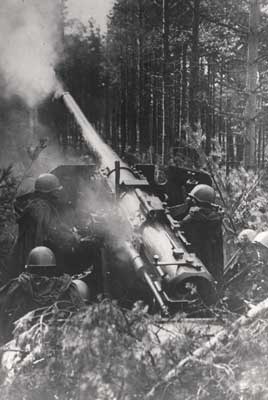 |
Artillery of the Red Army
Part One: Field Artillery
By Ian Galley
The Red Army has a long tradition of favouring the artillery arm. Soviet commanders called the artillery the "God of War" and believed it to be a decisive, battle-winning arm. The Soviet Union began a program of modernising its artillery arm during the 1930s, and so entered World War Two with a range of very modern and effective guns and howitzers.
The surprise German invasion in 1941 threw the Red Army into chaos and a huge amount of men and equipment was lost. It took time to rebuild the artillery arm up to full strength and potency, but by the late war period the Soviet army was renowned for the strength and power of its artillery.
Indirect Fire
The artillery fired indirectly to prepare the way for an assault, to bring down defensive walls of fire in front of Soviet troops under attack, as well firing in counter-battery roles to destroy enemy artillery.
|
|
Due to communications problems Soviet artillery doctrine emphasised making detailed plans covering hours or even days of firing before and during an attack. The level of pre-planning was necessary because the army was not as capable of doing the sort of flexible, impromptu fire called in by observers that the Americans and British excelled at.
The enemy positions were to be smashed by this intense preparatory bombardment to allow the attacking infantry to easily breakthrough, the masses of armour would pour through the gap created in the enemy lines. As the war progressed the Red Army fielded heavier and heavier concentrations of artillery. Artillery density often reached 320-480 pieces per mile of front in late war battles. German defenders reported that the Soviet bombardments were crushingly heavy but not always that precise or accurate. Skilled German commanders, such as Colonel General Heinrici learnt to evacuate their forward defensive line just before the Soviet bombardment was scheduled to begin.
|
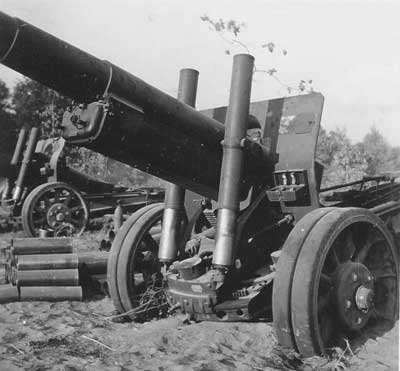 |
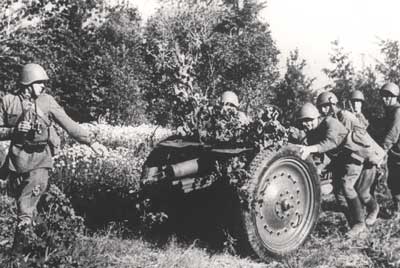 |
The Red Army employed 122mm howitzers as the backbone of its indirect fire bombardments, supplemented by 152mm howitzers. Corps level 122mm guns and 152mm gun howitzers would be used to pulverise enemy strong points.
The Direct Fire
The Red Army placed much greater emphasis on using the artillery in a direct fire role (as opposed to shelling an out of sight target indirectly) than other armies of the time. Soviet doctrine encouraged gunners to drag their weapons forward and blast the enemy over open sights. There were a number of reasons for this:
|
Direct fire was less wasteful of ammunition than indirect shelling which was considered an inefficient way of destroying the enemy. The Soviet Union experienced severe ammunition shortages for its artillery early in the war. This was because the ammunition factories were mostly positioned further west than the gun factories. In 1941 the invading German army quickly overran the ammunition production facilities, while many of the artillery factories were evacuated to safety. As a consequence, there was a massive imbalance between the number of guns produced and the amount of ammunition produced. By the end of 1942 the Soviets had increased gun production three times faster than they increased ammunition production. Ammunition shortages encouraged the use of direct fire.
|
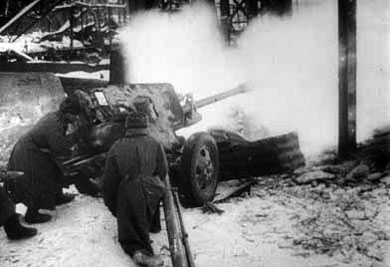 |
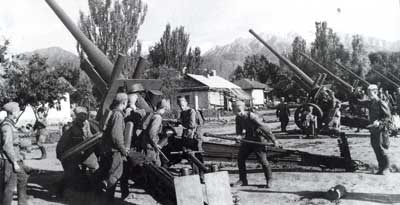 |
Also, the Red Army was always short of radios and this made it difficulty to arrange artillery fire at short notice. The Red Army mainly relied on field telephones to communicate, and telephone lines were cumbersome to lay and vulnerable to being severed by enemy fire.
Finally, the educational standards of the Red Army were, on average, lower than most other armies of the time. This, combined with the difficulty of providing training to such a large army, meant that it was difficult to train enough observers for the artillery army.
|
|
Therefore, the artillery crew often had no choice but to go forward and shell the enemy directly.
Because of the emphasis on direct fire, Red Army artillery pieces were
designed to be as light as possible. This made them easier for the
crews to manoeuvre into new firing positions on the front line.
|
|
Being on the front-line so often meant that life was more dangerous for Red Army gunners that for artillerymen of other nations. However, as the war progressed the crews became more skilled at using their weapons at the front. Evgenii Monyushko recalls how he and his comrades dug their weapons in at the Sandomierz bridgehead battle in 1944:
"Two holes were made to the left and right of a gun’s wheels - one for the gunner, the other for the loader. Practically, ZIS-3 guns didn’t require simultaneous presence of the entire crew near the gun. Moreover, it was usually enough for only one person to be present. The gunner, after firing, could hide himself in his hole while the loader would drive the next shell into the barrel. Now the gunner could take his place, aim, and fire, and the loader would be taking cover at that time. Even after a direct hit into the gun at least one of the two had a chance to survive. The other crew members were spread out through the holes, side "pockets" of the trench. Practical experience, which was being accumulated in this regiment, starting as far back as the Battle of the Kursk Salient, allowed [the guns crews] to minimize casualties."
The Main Soviet Guns
|
Field Artillery
ZiS-3 76.2mm
Weight: 1120kg
Shell weight: 6.21kg
Max Range: 13,000m
Rate of Fire: up to 25 rpm
|
|
|
Divisional Level Support
Obr 1938 122mm Howitzer
Weight: 2250kg
Shell weight: 21.76kg
Max Range: 12,100m
Rate of Fire: 5-6 rpm
Obr 1939 152mm Gun-Howitzer (ML-20)
Weight: 7128kg
Shell weight: 43.5kg
Max Range: 17,265.m
Rate of Fire: 1 rpm
|
Corps Level Support
Obr 1931/37 122mm Gun (A-19)
Weight: 7907kg
Shell weight: 25kg
Max Range: 20,400m
Rate of Fire: 5-6 rpm
Obr 1938 152mm Howitzer (M-10)
Weight: 4100kg
Shell weight: 40kg
Max Range: 12,400m
Rate of Fire: 2-4 rpm
|
|
Mortars and Rockets
The Red Army made extensive use of mortars, some of them of a very large calibre. They were often employed en masse like conventional artillery. Mortars had the advantage of being simple to produce, and relatively lightweight and so easy to move (which was important in the Red Army as there was always a shortage of gun tractors). The Soviets used 50mm, 82mm, 107mm, 120mm and 160mm Mortars. The 120mm was one of the best artillery pieces of the war, and could throw a 16kg bomb out to 6000 metres. The Germans thought it was so good they copied the design. The massive 160mm mortar fired a round containing more explosive filler than the 152mm howitzer (the 160mm fired a bomb weighing 41.14kg) and was the only brand new artillery piece the Soviets put into production in the entire war.
The Russians employed large quantities of rocket artillery and would mass them at critical points before an assault. Rockets started development in the Soviet Union in the early 1930s, at the Gas Dynamics Laboratory in Leningrad. They were considered top-secret weapons and very little was known about the extent of Soviet rocketry outside of the Soviet Union. The rocket launcher batteries were called "Guards Mortar" batteries to hide their true nature.
|
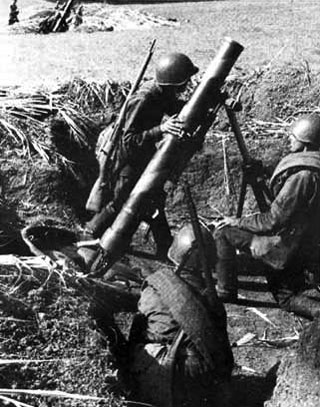 |
|
Their first use against the invading German, near Orszy in July 1941,
came as a great surprise to the enemy. German troops came to hate and
fear the devastating bombardments that the rocket launchers (called
’Katyusha’, meaning Katie, or little Kate) would unleash without
warning.
The first Soviet rockets were 82mm in calibre. They were commonly fired from the M-8 launcher. The M-8 carried 36 82mm rockets in three rows. Soon after, the 132mm rocket was introduced. Fired from the M-13 launcher, which held 16 132mm rockets in two rows of eight. Both of these rocket types were mounted on a wide variety of vehicles - not only trucks, but also T-60 and T-70 light tanks, artillery tractors and even captured vehicles.
|
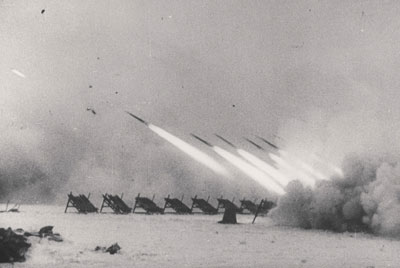 |
Larger rockets of 300mm and 310mm calibre were also used. Mostly these were fired from ground mounted, static frames (not unlike the German schweres Wurfgerat 40 or 41 heavy rocket launchers). These were used for pre-planned, set-piece attacks. They could also be mounted on the M-31 mobile launcher.
Close up: The 76.2mm ZIS-3 Field Gun
The mainstay of the Red Army artillery arm was the 76.2mm ZIS-3 gun. Officially accepted into service in early 1942, the ZIS-3 replaced the previous 76.2mm gun - the M.1936. The M.1936 was an excellent weapon, but too heavy, complex and expensive for Soviet needs.
|
|
An attempt was made to improve and lighten the M.1936 - resulting in the M.1939 or F-22 USV gun, which had a shortened barrel. But the Germans captured the factory that made the carriage for the
F-22 (but they didn’t capture the factory that made the guns).
The ZIS-3 was created by mating the gun from the M.1939 with the carriage of the 57mm ZIS-2 anti-tank gun. The ZIS-2 carriage couldn’t stand the power of the recoil from the 76.2mm gun so a muzzle brake was fitted. The ZIS-3 became the first Soviet field gun to be equipped with a muzzle brake.
|
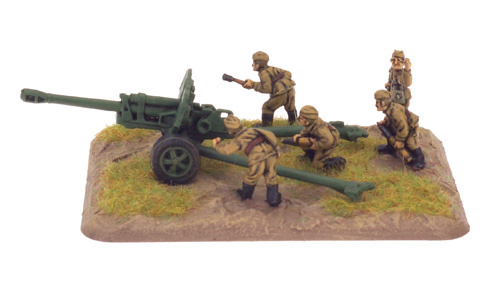 |
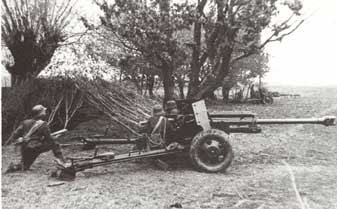 |
The ZIS-3 was very well designed and simple to produce. It took 2034 hours to construct an M.1936 gun, 1300 hours to construct an M.1939 gun, but only 909 hours to make a ZIS-3. Over 48,000 ZIS-3 guns were produced during the war, and it was a mainstay of many countries artillery forces for a long time afterward.
The ZIS-3 was a very lightweight gun for its size, and was used in a direct fire role about as often as it was used for indirect fire. The weapon served as a dual-purpose gun - capable of being used in an anti-infantry or anti-tank role. Soviet doctrine required all artillery pieces to
be used as anti-tank weapons when the situation required; even if the
guns had no armour-piercing ammunition they were expected to engage
German panzers with high-explosive.
|
|
German tanks crews could find them
selves being engaged by some very large calibre weapons -- 122mm, 152mm
or even larger!
Despite being of a much smaller calibre than the standard German medium artillery piece (the 10.5cm leFH18 howitzer) of the war, the ZIS-3 outranged the German howitzer. The Russian gun weighed almost half as much as the German weapon, and had a much higher rate of fire.
|
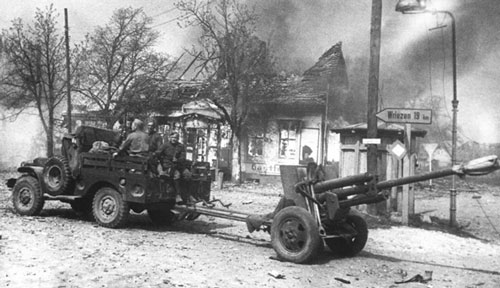 |
|
Of course, the 76.2mm shell didn’t possess the
hitting power of the 10.5cm round, but by firing directly at the target
Red Army gunners could put their shells a lot closer to the enemy --
compensating for the smaller size of the projectile.
The Germans called the ZIS-3 "Ratsch-Bum" because of it’s sound. When
being shelled, first came the buzzing noise of the shell ("ratsch") and
then the sound of explosion ("bum"). The German Army were greatly
impressed by the ZIS-3 and employed many captured weapons against their
former owners. In German service the ZIS-3 was called the 7,62cm FK
288(r).
Part Two: Red Army self-propelled artillery...
|
Last Updated On Thursday, November 6, 2014 by Blake at Battlefront
|
|
|